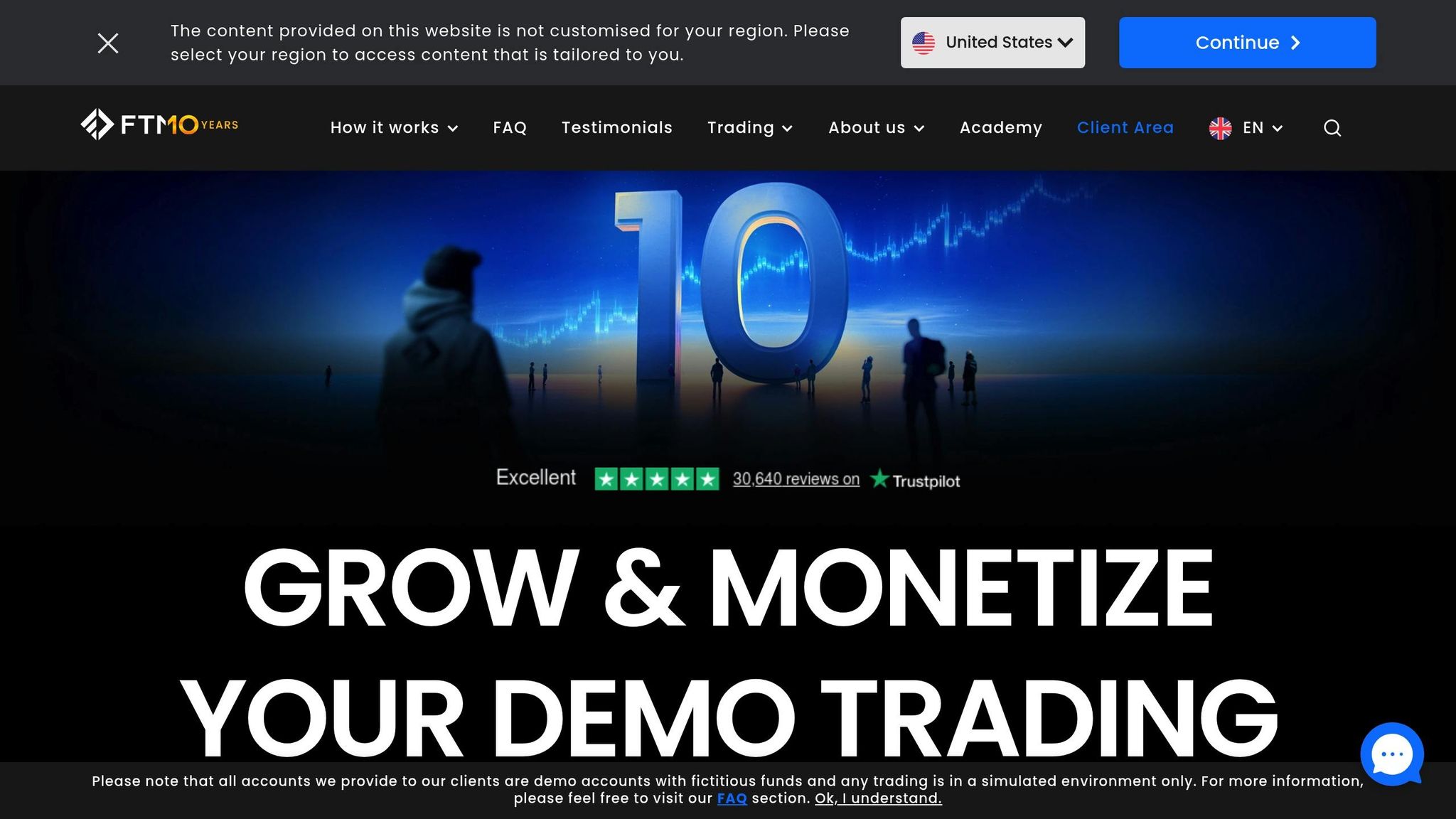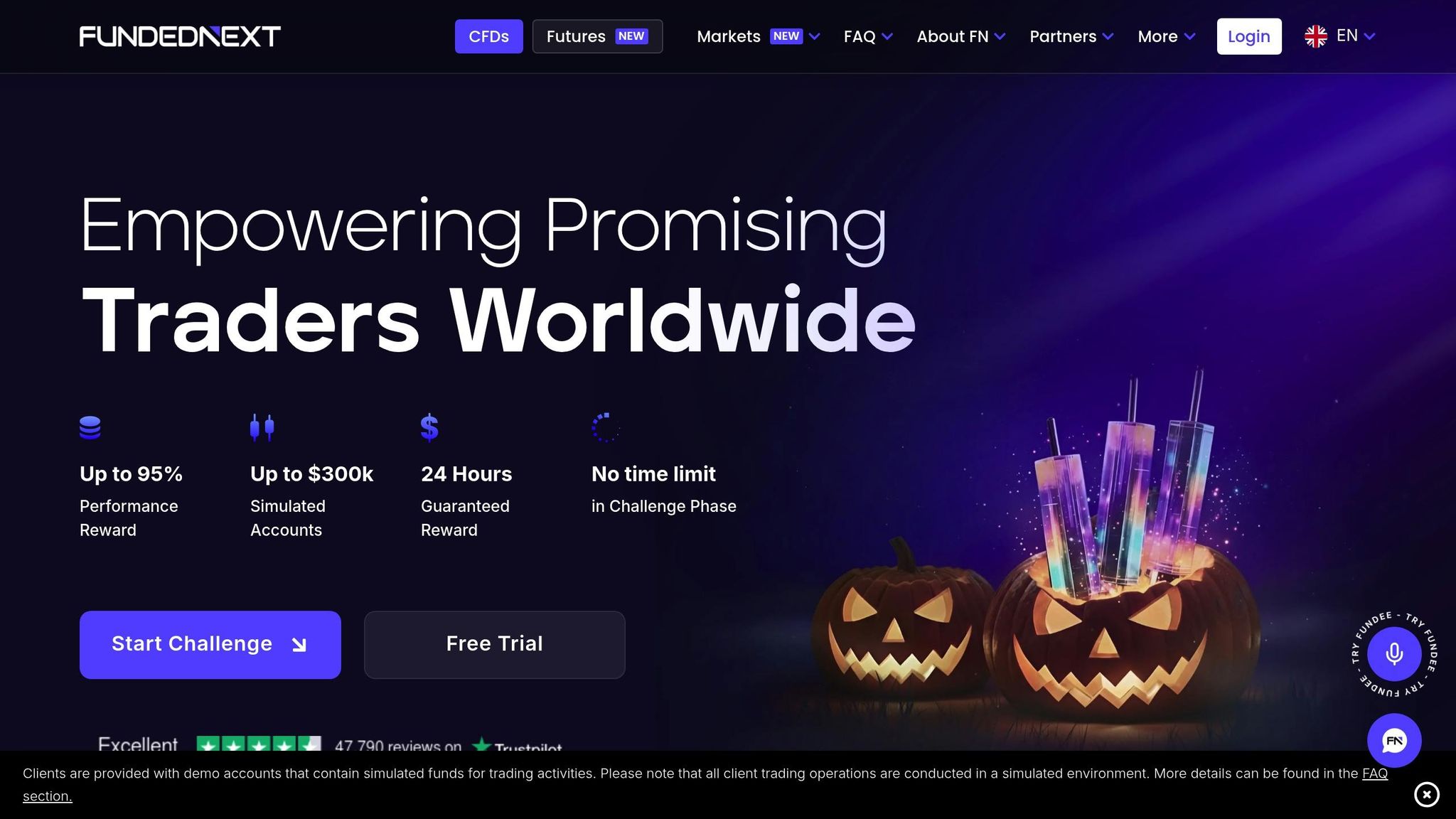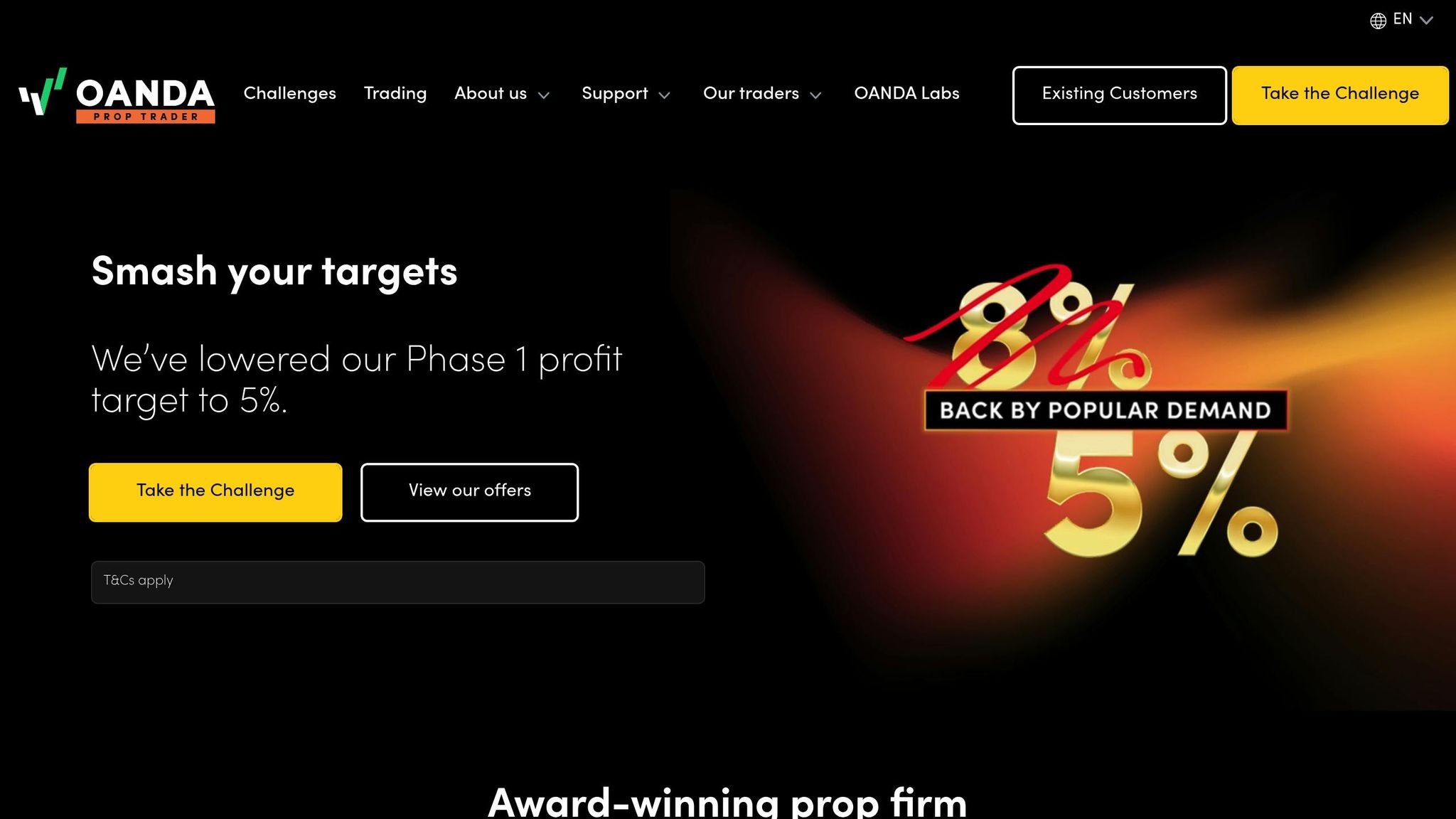Proprietary trading firms (prop firms) provide traders with access to significant capital in exchange for a share of profits. A key factor when choosing a prop firm is their drawdown rules, which define how much loss an account can endure before breaching risk limits. Low drawdown policies are especially important for traders focused on risk management and capital preservation.
Here are the top 5 prop firms with low drawdown rules:
- For Traders: Fixed 5% drawdown across all account sizes, 15% profit share, unlimited time to hit profit targets, and AI-powered risk tools.
- FTMO: 10% max drawdown, 5% daily drawdown, 80%-90% profit share, and access to MetaTrader and cTrader platforms.
- FundedNext: Multiple account types with flexible drawdown limits, refunded evaluation fees, and fast profit withdrawals.
- CFT (Crypto Funded Traders): 10% max drawdown, 5% daily loss limit, 80% profit share, and a focus on cryptocurrency trading.
- OANDA Prop Trader: Trailing drawdown system, daily loss limits, and a performance-based profit-sharing model.
Each firm offers unique features, from fixed or trailing drawdown limits to profit-sharing percentages and platform options. Understanding these policies helps traders find a firm that matches their trading style.
Quick Comparison
| Feature | For Traders | FTMO | FundedNext | CFT | OANDA Prop Trader |
|---|---|---|---|---|---|
| Max Drawdown | 5% fixed | 10% fixed | Flexible | 10% fixed | Trailing (equity-based) |
| Daily Drawdown | Strict limit | 5% | Moderate | 5% | Daily reset mechanism |
| Profit Share | 15% | 80%-90% | Competitive | 80% | Performance-based |
| Platforms | DXTrade, cTrader | MT4, MT5, cTrader | MT4, MT5 | MT5, proprietary | MT4, proprietary |
| Focus | Risk-conscious traders | Balanced traders | Flexible styles | Crypto traders | Cautious traders |
Choose a firm that aligns with your trading style and risk tolerance to maximize your success.
Master Daily and Max Drawdowns with Prop Firms and to Never Breach them
How to Choose Low Drawdown Prop Firms
To manage risk effectively, it’s essential to understand how drawdown rules work.
Different firms calculate drawdown in different ways. Balance-based drawdown considers only realized profits and losses, meaning your open trades don’t impact the drawdown limit. On the other hand, equity-based drawdown accounts for both realized and unrealized profits and losses. This means your drawdown limit can shift based on the performance of your open trades. For example, if you’re trading on a $100,000 account with a $5,000 drawdown limit and make a $2,000 profit, the equity-based threshold adjusts to $97,000.
Traders who hold positions for longer periods, like swing traders, often lean toward balance-based drawdown rules. These rules allow more flexibility, giving traders some breathing room during market fluctuations.
Grasping these drawdown calculation methods is key when evaluating prop firms. It ensures that the firm’s risk management policies align with how you trade. With this foundation in mind, let’s explore the top prop firms offering low drawdown limits.
1. For Traders

When it comes to firms with strict risk controls, For Traders stands out with its 5% drawdown policy. This platform combines conservative risk management with flexible trading conditions and access to significant virtual capital.
Maximum Drawdown Percentage
For Traders enforces a 5% maximum drawdown across all account sizes, making it one of the most cautious options in the market. Whether you're trading with a $6,000 account or managing $100,000 in virtual capital, this 5% limit remains consistent. It’s designed to balance market fluctuations while safeguarding capital and maintaining steady profit opportunities.
Profit-Sharing Policies
Traders on this platform receive a 15% profit share across all account tiers - from the $6,000 plan to the $100,000 option. This uniform rate ensures transparency, so traders always know what to expect, regardless of their account size.
Payouts are processed on a bi-weekly basis, offering quicker access to earnings compared to monthly schedules. Additionally, the platform’s 9% profit target is paired with an unlimited time frame, allowing traders to work at their own pace without feeling rushed.
Platform Support
For Traders gives users access to three advanced trading platforms: DXTrade, TradeLocker, and cTrader. This variety ensures traders can choose the platform that best aligns with their trading strategies and technical preferences.
The platform also incorporates AI-powered risk management tools to complement its low drawdown limits. These tools provide real-time monitoring of positions and risk exposure, helping traders stay within the 5% drawdown threshold.
On top of that, For Traders offers a range of educational resources, including 12+ video courses, e-books, and access to a Discord community. These resources are designed to sharpen risk management skills and support traders in achieving their goals.
Next, we’ll take a closer look at FTMO to see how its policies stack up.
2. FTMO

FTMO, a Czech-based company with over a decade of experience, provides traders with a structured risk management system, including a maximum drawdown of 10%. Let’s take a closer look at how FTMO handles risk and what it offers its traders.
Maximum Drawdown Percentage
FTMO maintains a fixed maximum drawdown of 10%, regardless of the account size. Whether you’re starting with their $10,000 account or managing a larger funded account, this limit stays the same. This consistency allows traders to accumulate profits and create a cushion during periods of market volatility.
Daily Drawdown Limits
In addition to the overall drawdown, FTMO enforces a 5% daily drawdown limit, which resets at midnight Central European Time. If a trader exceeds this daily limit, the challenge ends. This makes position sizing critical - risking 3–4% on a single trade could result in hitting the limit after just a couple of losing trades.
Profit-Sharing Policies
FTMO offers an attractive profit-sharing model, allowing funded traders to keep 80–90% of their earnings. Withdrawals are processed quickly, ensuring traders can access their profits without delays. Funded accounts start at $10,000, with entry fees beginning at €89, making it a good option for those with low-risk trading strategies.
Platform Support
FTMO supports popular platforms like MetaTrader 4, MetaTrader 5, and cTrader. Traders can also use Expert Advisors (EAs) to automate their strategies. The company provides 24/7 customer support in 18 languages, ensuring assistance is readily available when needed.
However, there are some limitations to consider. FTMO no longer accepts US-based traders, restricting this opportunity to international participants. Additionally, the firm does not disclose details about which brokers handle trade execution. Despite these drawbacks, FTMO remains a strong choice for traders looking for a balance between risk control and flexibility.
3. FundedNext

FundedNext stands out by offering account setups designed to align with varying risk management strategies. With flexible drawdown policies, it caters to traders with different levels of risk tolerance.
Maximum Drawdown Options
FundedNext provides several account types, each with unique drawdown thresholds to match diverse trading styles. These include the Evaluation account, which features standard limits, the Express account for those seeking more conservative thresholds, and a balanced option for moderate risk preferences. Additionally, traders can choose from a range of account sizes to match their specific needs.
Daily Drawdown Limits
Each account type comes with its own daily drawdown limits, which reset on a fixed schedule, ensuring traders have clear boundaries to manage their risk effectively.
Profit-Sharing and Fee Structure
FundedNext offers a profit-sharing model that varies depending on the account type, making it competitive for traders at all levels. Withdrawals are processed quickly, and the evaluation fee is refunded after the first profitable withdrawal. This approach not only rewards successful traders but also reinforces the platform's commitment to fair and transparent practices.
Platform and Support
Traders can use MetaTrader 4 and MetaTrader 5, supporting both manual and automated trading strategies. FundedNext also provides strong customer support through various channels, alongside educational tools and resources to help traders improve their skills and manage risk more effectively. The platform is accessible to traders from many countries, including the United States, ensuring a broad reach for its services.
sbb-itb-9de3b6e
4. CFT (Crypto Funded Traders)

CFT (Crypto Funded Traders) focuses on cryptocurrency trading with a cautious approach to drawdown limits. Since its establishment in 2022, the firm has educated over 30,000 traders and distributed more than $10 million in payouts.
Maximum Drawdown Percentage
CFT enforces a strict 10% maximum drawdown, which is calculated based on the initial account balance. Traders can choose from six funded account options, starting at $5,000, allowing flexibility based on individual risk tolerance and capital availability.
Daily Drawdown Limits
To ensure disciplined trading, CFT sets a daily loss limit of 5%, which resets at the start of each trading day. Combined with the 10% maximum drawdown, this system creates a solid risk management structure.
Profit-Sharing Policies
CFT offers an 80% profit share through a two-phase evaluation process. Phase 1 requires an 8% profit target, while Phase 2 lowers the target to 5%, with no minimum trading days required. Entry fees begin at $68, and withdrawals can be made in cryptocurrency, providing added convenience for traders.
Platform Support
CFT supports trading on MetaTrader 5+ and its own proprietary platforms, offering advanced tools for charting and automation. While the firm prioritizes cryptocurrency markets, it also covers a range of other asset classes, including Forex, Equities, Commodities, and Index trading.
Commission rates vary by asset class: Forex – $3.00 per standard lot, Equities – 0.002% per side, Commodities – 0.0005%, Crypto – 0.025%, and Index trading is commission-free. Additional features include personal mentoring and blockchain-verified proof of emergency fund reserves, providing traders with added confidence and security. Up next, we’ll dive into OANDA Prop Trader's strategy for managing low drawdown risks.
5. OANDA Prop Trader

OANDA Prop Trader is tailored for traders who prefer a cautious approach, offering a strategy designed to minimize risks. With a strong foundation in forex market expertise, the program incorporates various risk management tools to create a controlled trading environment. Let’s break down its key features:
Maximum Drawdown Percentage
The program uses a trailing system to determine the maximum drawdown limit, based on the account's equity peak. As traders generate profits, the allowable drawdown adjusts upward, effectively protecting gains while reducing overall risk exposure.
Daily Drawdown Limits
To help traders manage daily market fluctuations, OANDA Prop Trader imposes daily loss limits that reset at the end of each trading day. This approach prevents excessive losses within a single day while allowing room to handle market volatility.
Profit-Sharing Policies
After successfully completing the evaluation process, traders who meet the program's performance benchmarks qualify for a profit-sharing arrangement. Structured evaluations and the option for monthly withdrawals provide incentives for consistent and disciplined trading.
Platform Support
OANDA Prop Trader offers access to both MetaTrader and OANDA’s proprietary trading platform. These platforms feature advanced charting tools, automation capabilities, and integrated risk management functions to ensure a smooth and efficient trading experience.
This wraps up our overview of top proprietary trading firms with low drawdown options.
Side-by-Side Comparison
When evaluating prop firms, it's essential to consider how their features align with your trading style and risk management preferences. The table below breaks down key aspects of several firms for an easy, side-by-side comparison.
| Feature | For Traders | FTMO | FundedNext | CFT | OANDA Prop Trader |
|---|---|---|---|---|---|
| Maximum Drawdown | Fixed 5% drawdown limit | Fixed limit system | Fixed limit system | Fixed 10% drawdown on initial balance | Equity-based trailing approach |
| Daily Drawdown | Enforces a strict daily limit | Moderate daily limit | Moderate daily limit | Fixed 5% daily loss limit | Daily reset mechanism |
| Account Sizes | Offers a broad range to suit various trader levels | Moderate funding ranges | Accessible entry-level funding | Lower minimum funding required | Options for larger account sizes |
| Profit Split | High profit-sharing potential | Competitive profit split | Competitive profit split | Balanced profit-sharing model | Performance-based profit-sharing model |
| Platform Support | Access to multiple leading platforms | Supports well-known platforms | Focuses on commonly used platforms | Emphasizes widely adopted systems | Combines leading platforms with proprietary options |
| Educational Resources | Comprehensive training, including academies and webinars | Market insights and resources | Strong community and learning focus | Specialized educational materials | Market analysis and trading tools |
| Payout Methods | Flexible options, including traditional and digital channels | Established transfer methods | Various withdrawal options | Digital payout methods prioritized | Standard banking and online payment options |
Each firm has its own approach to balancing risk management and trader support. For instance, some firms use dynamic drawdown systems that adjust based on account performance, while others stick to fixed limits. Similarly, funding options, profit-sharing structures, and educational resources vary, allowing you to choose the firm that aligns best with your trading goals and risk tolerance.
Final Thoughts
Selecting a prop firm with low drawdown rules can play a major role in building long-term trading success. Each firm we’ve reviewed brings its own approach to managing risk, emphasizing the idea that protecting your capital is just as crucial as growing it.
For example: For Traders offers a fixed 5% drawdown, making it a great choice for conservative traders. FTMO and FundedNext strike a balance with moderate risk rules, while CFT tailors its approach to handle crypto's volatility. On the other hand, OANDA uses a dynamic drawdown system to adjust as needed. These diverse strategies show how important it is to align with a firm that complements your personal trading style.
When choosing, think about how much flexibility you need. If you prefer more room to operate, go for a firm with looser rules. If you thrive on structure and discipline, opt for one with stricter controls. Also, don’t overlook other factors like profit-sharing percentages and the availability of educational tools - they can make a big difference in your overall experience.
Take the time to evaluate your own risk tolerance and trading preferences before committing. The right prop firm should feel like a partner, offering the support you need to grow while keeping risks manageable.
With professional capital and structured risk management now within reach, traders at all levels - whether starting out or scaling up - can find the tools and support needed to navigate today’s markets with confidence.
FAQs
What should I look for in a prop firm with low drawdown rules?
When selecting a prop firm with low drawdown rules, it's crucial to get familiar with their specific policies. These typically fall into categories like balance-based, equity-based, trailing, or fixed models. One key detail to note is the stop-out level, which indicates the point at which your account may be closed due to losses.
It's equally important to ensure the firm's rules match your trading style and risk tolerance. Careful management of position sizes and maintaining discipline during volatile markets can help you stay within drawdown limits. Opting for a firm that aligns with your risk management approach allows you to trade with more confidence while safeguarding your account.
What’s the difference between balance-based and equity-based drawdown calculations, and how do they affect trading strategies?
Balance-based drawdown calculations focus on losses in relation to the account's starting or current balance. This approach suits traders who value a steady, conservative growth path. By emphasizing account stability, it encourages disciplined risk management and helps traders maintain control over their finances.
In contrast, equity-based drawdowns measure losses based on the account's real-time equity, which shifts as open trades fluctuate. This method offers more flexibility but demands constant attention to market conditions. Traders need to adapt their strategies quickly to stay within drawdown limits, making this a more dynamic - but potentially riskier - option.
Grasping these distinctions allows traders to match their drawdown approach with their risk appetite and trading objectives, helping them stay aligned with their preferred trading style.
What are the advantages of using a prop firm with a fixed drawdown limit compared to one with a trailing drawdown system?
Choosing a prop firm with a fixed drawdown limit gives traders a steady and predictable risk boundary. This consistency makes it easier to plan strategies and stick to them, knowing the drawdown limit won’t shift as the account fluctuates. It also helps minimize emotional decisions and shields against unexpected account losses.
In contrast, a trailing drawdown system adjusts as your account grows, offering the chance to benefit from profitable trends. While this setup can boost potential gains, it demands close attention. Since the drawdown limit moves alongside profits, there’s a higher chance of encountering larger losses if not carefully managed.
The right option boils down to your trading approach and comfort with risk. Fixed drawdowns work well for those who prioritize stability, while trailing systems appeal to traders aiming for growth and willing to take on more risk.


